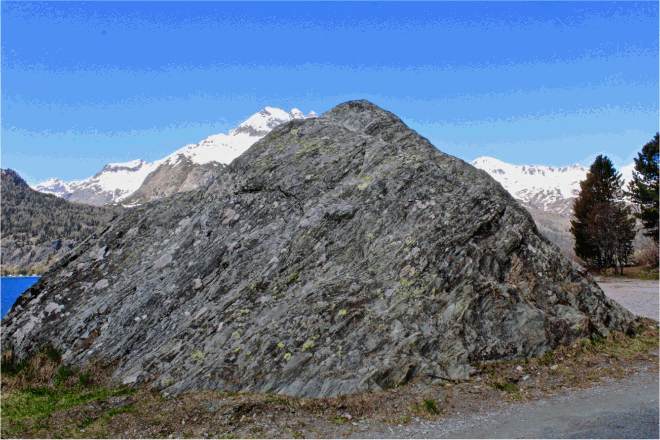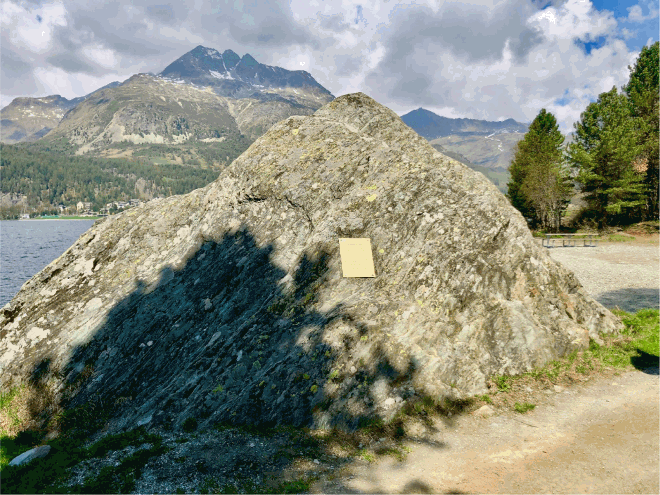The first time I encountered the Rock, I tried to imagine Nietzsche’s experience and what it must have felt like to come to the rock for the first time. He tells us, of course, of the thought that changed it all for him – that everything comes again, nothing new in its re-coming to us, again and again and all in the self-same way in its timeless enfolding into itself and unfolding into the world.Footnote1 I viewed the Rock from as many perspectives as I could – I even viewed the rock from the lake side as much as I could manage without getting my feet too wet on this cold Lake Silvaplana day in May. On this day, I touched the rock, smelled it, and wondered about its taste. Did Nietzsche ever do these same things? I imagine he did. Is he eternally doing these things if he once did?
Did he ever taste the rock out of curiosity? At least just once? I might have, but I’m keeping this a secret and will accept and affirm a life that pronounces the taste comes back to me, time and time again, eternally re-coming.
I also sat on the rock, leaned back on it, and tried to enter the stone as Isamu Noguchi once said to his assistant, but this time, in my time, without a hammer or chisel. I wanted to get into the rock’s silence and just be in its world, just like the Rock of Eternal Re-coming. I spoke to the rock, as if it could listen, and it only replied to me in its silence amidst the heightening sounds of the winds moving clouds over and through the peaks of the vertical mountains around Silvaplana. The clouds came to us too on our portion of the land that surrounds Silvaplana Lake. As I listened to the monolithic rock’s silence, I saw more clearly the syntax of its utterances of silence coming again, and again – eternally – until they were silently audible.
What feeling had possessed Nietzsche when the thought came to him? Did he spontaneously disperse as the cloud of his self converged with the peak of this pyramidal rock that positioned itself between land and lake? Did he diffuse floating over the lake’s water and swirl upward to the monumental peaks of the surrounding alpine mountains in the Engadin? I tried to channel the nearsighted philosopher and retraced my steps as I came upon the rock down the pathway, from the direction he must have come from his rental lodging with the Durisch family in Sils Maria Village. Is this the spot where he saw the rock first when he turned the corner that I was now turning? With his poor vision, it is unlikely he saw it from the distance as we did when we approached. My guess is that he was just walking and waiting for the thoughts to come with his notebook in his jacket pocket to jot down his insights. And then, the Rock came into his view, as it re-came into mine, once again.
What this Rock meant to Nietzsche was everything; for him, everything crystalized in this pyramid-shaped rock that embedded its base in the earth and with its peak reaching for the sky. Although Nietzsche never read Levy-Bruhl, I think he would have appreciated his idea of primitive participation that was reinstated in this rock’s language. In its fractal congruence, the Rock resonates with the surrounding peaks of the Engadin – for it displays a self-similarity of all that is becoming in its world; all that is world. I thought about this again at the Rock and shared it with Graham Parkes. This was my second pilgrimage. This time was with Parkes and Timothy Freeman, with whom I had made my first journey. But for both of us, this time was even more memorable because of Parkes’s presence. We spent a morning and afternoon with the Rock, moving about in silence with only occasional words between us.
We each were aghast when we saw what had happened to the Rock. But we will it to come to us again, as it once was.

Spoiling the surface of something, its appearance, even with a marker that is supposed to memorialize it, is the worst of all things for a philosopher of appearance, for a thinker who valued the appearance of things that need to be saved. As Nietzsche writes in the Joyous Science on the consciousness of appearance,
I suddenly woke up in the midst of this dream, but only to the consciousness that I am dreaming and that I must go on dreaming lest I perish – as a somnambulist must go on dreaming lest he fall. What is “appearance” for me now? Certainly not the opposite of some essence: what could I say about any essence except to name the attributes of its appearance! Certainly not a dead mask that one could place on an unknown x or remove from it!
Appearance is for me that which lives and is effective and goes so far in its self-mockery that it makes me feel that this is appearance and will-o’-the-wisp and a dance of spirits and nothing more – that among all these dreamers, I, too, who “know,” am dancing my dance; that the knower is a means for prolonging the earthly dance and thus belongs to the masters of ceremony of existence; and that the sublime consistency and interrelatedness of all knowledge perhaps is and will be the highest means to preserve the universality of dreaming and the mutual comprehension of all dreamers and thus also the continuation of the dream. (Kaufmann 116)
If for Plato philosophers have the serious task of waking from the dreamworld and discovering the truth while artists are lost in the dreamworld playing with fictions, Nietzsche’s response is that philosophers have always been artists whether they have realized it or not. The philosophers of the future will recognize that they are artists and thus they will have awakened to the lucid dream that is philosophy.
And later we walked along those trails Nietzsche once walked. Nietzsche had distrusted any idea that came to him when he wasn’t touching the earth with his feet while his legs were in their walking movement, moving with the earth. Everything is moving in our world, even the terra firma we call Earth. Nietzsche had earlier realized this from his ancient teacher Heraclitus who also knew the sacred was found across the scale of all that is, for “The god is day/night, wintertime/summertime, war/peace, satiety/hunger …” (Fragment 67). In his response to Flaubert’s “On ne peut penser et écrire qu'assis” (One can think and write only when sitting down) in section 34 of “Maxims and Arrows” in Twilight of Idols, Nietzsche is not reticent to point out Flaubert’s error, “With that I have you, nihilist! Sitting (on your ass) for so long is the unnatural sin against the sacred spirit. Only ideas coming out of walking have worth.”Footnote2 And we can think also of Descartes doing most of his thinking while lying in bed.
We walked in silence for the most part, occasionally across patches of snow where we could hear the crunching of the soles of our shoes on the white icy surface. Later in the evening, we returned to the Nietzsche-Haus. We would spend evenings there in Dionysian revelry and discuss elements of Nietzsche’s thinking. I imagined him sitting on occasion where we sat by the hearth, even though he took most of his meals elsewhere. We drank wine, talked about the bespectacled philosopher with the magnanimous mustache, and wondered why someone thought it was a promising idea to commemorate him by defacing his beloved Rock.

The editor is certain that this issue marks time far less intrusively than a gold commemorative tablet vandalizing the face of the Rock on the side Nietzsche likely saw first in his initial encounter of the Rock. Comparative and Continental Philosophy 14.1 commemorates the beginning of our fourteenth year of publishing this journal; a journal devoted to publishing innovative and provocative leading-edge papers by internationally respected scholars. In our previous thirteen years, CCP has extended the comparative philosophical conversation to include Latin American philosophy as well as opening a wider range of dialogue found in Western philosophy – one that is also inclusive of other disciplines, such as religion, art history, comparative literature, critical theory, phenomenological psychology, and cultural theory.
Comparative and Continental Philosophy 14.1 continues this spirit with a Special Featured Article, “The Way of Becoming-Imperceptible: Daoism, Deleuze, and Inner Transformation” by Brian Schroeder. Other articles in this issue include Russell J. Duvernoy’s “The ‘Beautiful Soul’ and ‘Religious Consciousness’: Deleuze and Nishida”; “The Eye is in Things: On Deleuze and Speculative Realism” by Pablo Pachilla; Daniele Fulvi’s “Kenosis and Nature: Critical Notes on Vattimo’s and Bubbio’s Notion of Kenotic Sacrifice”; and “Sylvia Wynter’s New Science of the Word and the Autopoetics of the Flesh” by Rafael Vizcaíno. This issue concludes with two review essays, “The Poetics of Hope: Treanor’s Invitation to the Mystery of Being” (Christopher Yates) and “On Nothingness in the Heart of the Empire and the Wartime Politics of the Kyoto School” (John W.M. Krummel).
My long-time friend Dennis Connor Shaw died last month, and I dedicate this issue to him. Dennis influenced my life in so many ways, and I am grateful to him for coming into my life when he did – I affirm, and re-affirm, his coming and re-coming into my life eternally. For without him, I likely would have just ineptly climbed mountains and fallen to my death, skied poorly and hurt myself, or die by the mauling of a mother bear for camping close to her berry bush. I had gone West as a young man primarily for these sorts of things, but Dennis saw more. I remember him telling me why he was an anthropologist and not a philosopher. It was a matter of choice for him, as it was for Claude Lévi-Strauss whom he studied, but his reasoning had perhaps a bit more guttural feeling tone to it than his teacher’s. Nevertheless, he resonated intellectually with Lévi-Strauss’s pronouncement in “How I became an Anthropologist”: “Anthropology affords me an intellectual satisfaction: it rejoins at one extreme the history of the world, and at the other the history of myself, and it unveils the shared motivation of one and the other at the same moment” (63). And this is why I, too, am a philosopher.
With special thanks to Rolf Siebenmann for his warmth, hospitality, and generosity.
Photographs by Timothy J. Freeman.
Notes
1 In conversation with Graham Parkes, we entertained his idea to consider using “re-coming” for Wiederkunft instead of “recurrence.” And the more I think on it, the more I appreciate it. I have invited Parkes to write something for Comparative and Continental Philosophy on this topic.
2 I have been somewhat imaginative with this quote but not without some justification. The German reads “Damit habe ich dich, Nihilist! Das Sitzfleisch ist gerade die Sünde wider den heiligen Geist. Nur die ergangenen Gedanken haben Werth.” Sitzfleisch has two meanings. One meaning refers directly to the buttocks and the second meaning refers to one’s ability to sit patiently for long periods of time.
References
- Chuang-tzŭ. 1981. Translated by A. C. Graham. London: George Allen and Unwin.
- Freeman, Timothy J. 2008. “Zarathustra’s Lucid Dream, Zhuangzi’s Supreme Swindle, and Nägärjuna’s Emptiness of Emptiness: Some Resonances between Nietzsche’s Written and Painted Thoughts and Asian Philosophy.” Unpublished manuscript.
- Nietzsche, Friedrich. 1968. Twight of Idols and the Anti-Christ. Translated by R. J. Hollingdale. Harmondsworth, Middlesex: Penguin Books.
- Nietzsche, Friedrich. 1974. The Gay Science. Translated by Walter Kaufmann. New York: Random House.
- Nietzsche, Friedrich. 2005. Thus Spoke Zarathustra. Translated by Graham Parkes. New York: Oxford University Press.
- Lévi-Strauss, Claude. 1970. Tristes Tropiques. Translated by John Russell. New York: Antheneum
